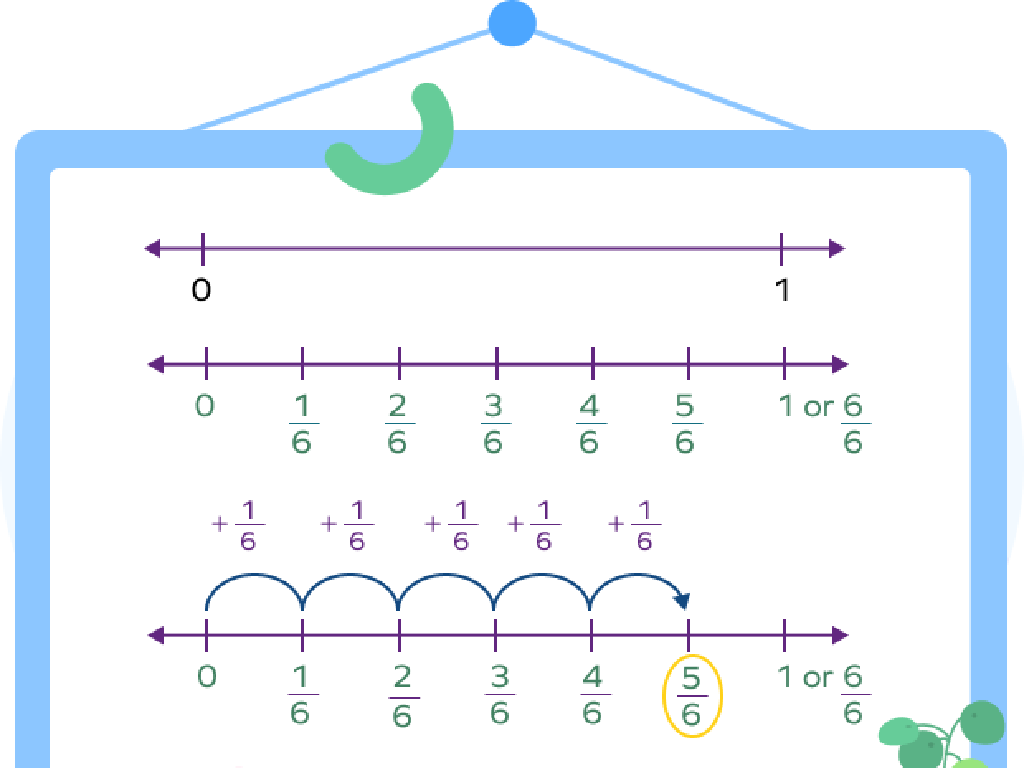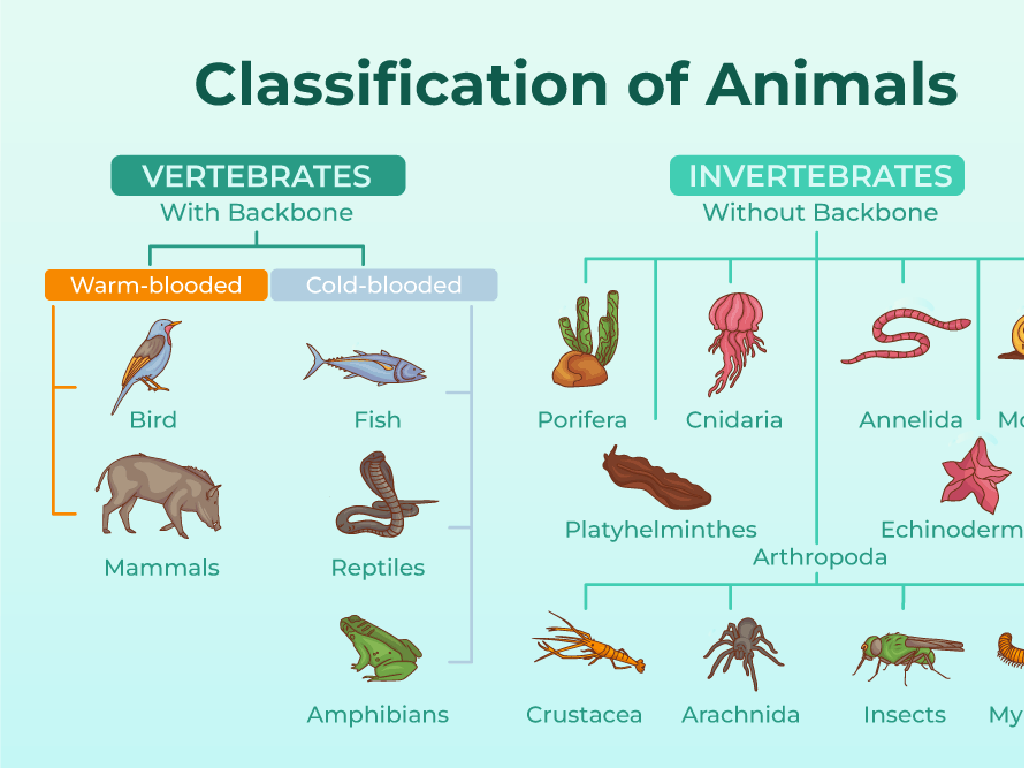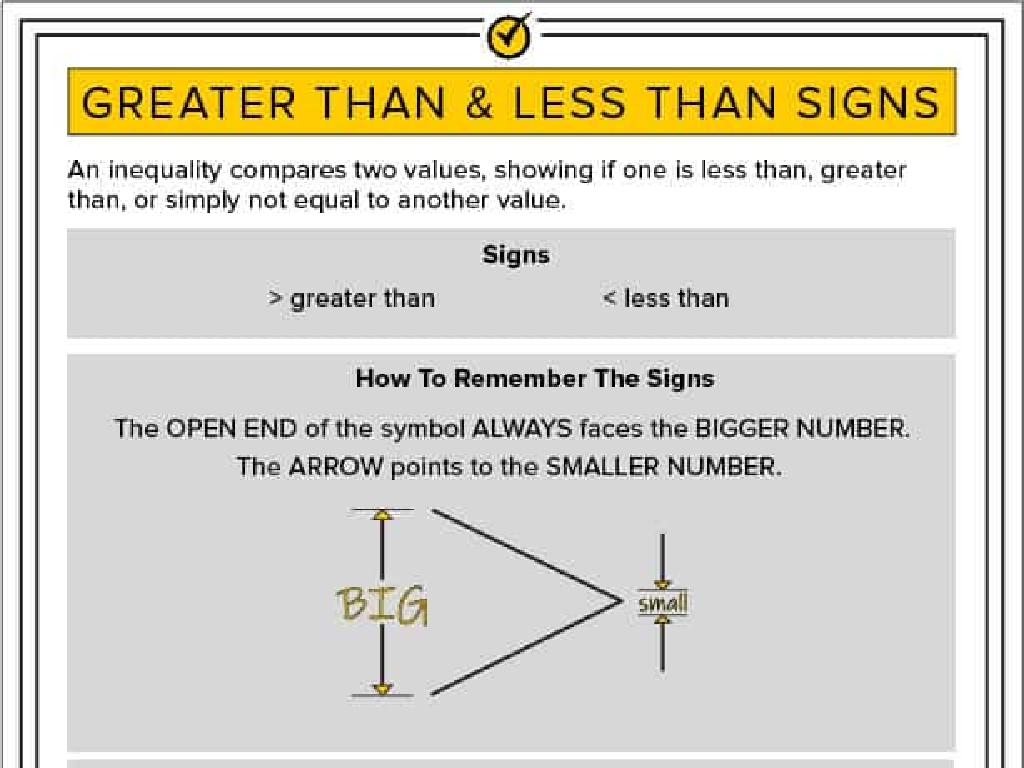Identify And Classify Polygons
Subject: Math
Grade: Seventh grade
Topic: Two-Dimensional Figures
Please LOG IN to download the presentation. Access is available to registered users only.
View More Content
Identifying and Classifying Polygons
– Explore two-dimensional figures
– Define and identify polygons
– Closed shape, straight lines, and no curves
– Classify polygons by sides
– Triangles, quadrilaterals, pentagons, etc.
– Discover polygons in daily life
– From architecture to art, polygons are everywhere
|
This slide introduces students to the world of two-dimensional figures, with a focus on polygons. Begin by discussing the characteristics of two-dimensional figures. Explain what polygons are, highlighting their features such as being a closed shape with straight lines. Move on to classification based on the number of sides, discussing different types such as triangles, quadrilaterals, and pentagons. Emphasize the relevance of polygons in everyday life, pointing out their presence in man-made structures and natural forms. Encourage students to observe and identify polygons in their surroundings, fostering a connection between the mathematical concepts and the real world.
Exploring Polygons
– Define a polygon
– A shape with straight sides, closed, and no curves
– Key characteristics of polygons
– Must have at least 3 sides, sides must not cross
– Polygon examples
– Triangles, squares, rectangles
– Non-examples of polygons
– Circles, shapes with curves or open sides
|
This slide introduces the concept of polygons to the students. Begin with the definition, emphasizing that polygons are two-dimensional figures with straight sides that are fully closed. Discuss the characteristics such as the polygons having a specific number of sides, vertices, and angles, and that the sides must not intersect each other. Provide clear examples of polygons like triangles, quadrilaterals, pentagons, etc., and contrast them with non-examples such as circles and open shapes to solidify understanding. Encourage students to identify and classify shapes in their environment to relate the concept to real life.
Types of Polygons
– Simple vs. Complex Polygons
– Simple polygons have non-intersecting sides, while complex ones may intersect.
– Regular vs. Irregular Polygons
– Regular polygons have equal sides and angles; irregular ones do not.
– Convex vs. Concave Polygons
– Convex polygons have no angles pointing inwards; concave polygons have at least one inward angle.
|
This slide aims to introduce students to the classification of polygons. Simple polygons are shapes like triangles and rectangles with sides that do not cross each other, whereas complex polygons have sides that can intersect, forming star shapes. Regular polygons are equilateral and equiangular such as squares and equilateral triangles, while irregular polygons do not have equal side lengths or angles, like most quadrilaterals. Convex polygons have all angles less than 180 degrees, with no indentations, whereas concave polygons have at least one angle greater than 180 degrees. Encourage students to draw examples of each and to look for these shapes in their environment.
Identifying and Classifying Polygons
– Recognizing polygons around us
– Look for flat shapes with straight sides, like street signs or tiles.
– Counting sides and vertices
– Polygons have equal number of sides and vertices. A triangle has 3 sides and 3 vertices.
– Quick polygon identification
– Does it have straight sides and is closed? If yes, it’s likely a polygon.
– Classifying types of polygons
– Based on sides, we have triangles, quadrilaterals, pentagons, etc.
|
This slide aims to help students identify and classify polygons both in the classroom and in the real world. Start by explaining what polygons are and how they can be spotted in everyday life, using common examples like street signs or floor tiles. Emphasize the importance of counting sides and vertices to determine the type of polygon. Teach students a quick method to check if a shape is a polygon: it should be a closed shape with straight sides. Finally, guide them to classify polygons based on the number of sides, from triangles (three sides) to n-gons (n sides). Encourage students to bring examples of polygons they find at home or outside to the next class for discussion.
Classifying Polygons
– Classify by sides count
– Polygons are classified by the number of sides they have.
– Name polygons: Triangle to Decagon
– Triangles have 3 sides, quadrilaterals have 4, pentagons have 5, and so on up to decagons with 10 sides.
– Classroom object classification activity
– Find objects in the classroom that resemble polygons and classify them based on their sides.
|
This slide introduces the concept of classifying polygons based on the number of sides they have. Start by explaining that a polygon is a 2-dimensional figure with straight sides. Show examples of different polygons and their names, from triangles (3 sides) to decagons (10 sides). For the activity, students will look for objects in the classroom that resemble these shapes and classify them accordingly. This hands-on activity will help solidify their understanding of polygons and their classifications. Provide guidance on how to count sides and verify shapes, and encourage students to discuss their findings. Possible objects could include a clock (circle, not a polygon), a door (rectangle), or a book (rectangle).
Angles in Polygons
– Interior vs. Exterior Angles
– Interior: inside angles. Exterior: outside angles.
– Sum of Interior Angles Formula
– Sum = (n-2) × 180°, where n is the number of sides.
– Regular Polygons’ Angles
– Regular polygons have equal interior angles.
– Class Activity: Angle Investigation
|
This slide introduces students to the concept of interior and exterior angles in polygons. Begin by explaining the difference between interior and exterior angles. Move on to the formula for calculating the sum of interior angles, where ‘n’ represents the number of sides in the polygon. Emphasize that this formula only applies to simple polygons (those that don’t intersect themselves). For regular polygons, which have sides of equal length, the interior angles are also equal. Conclude with a class activity where students will apply their knowledge by investigating angles in various polygons, calculating sums of interior angles, and identifying regular polygons. Provide examples like squares, triangles, and hexagons for the activity, and encourage students to draw and measure angles for hands-on learning.
Polygon Properties Exploration
– Understanding side lengths
– Each side of a polygon can be measured.
– Learning symmetry in polygons
– Symmetry refers to a balanced and proportional arrangement.
– Area and perimeter formulas
– Formulas for area and perimeter differ for each polygon.
– Polygons in the real world
– Examples: architecture, art, and nature.
|
This slide aims to introduce students to the fundamental properties of polygons, including side lengths, symmetry, and the mathematical formulas for calculating area and perimeter. Emphasize the importance of understanding these properties for classifying different polygons. Provide clear examples of symmetry and how it applies to regular polygons. Walk through the formulas for area and perimeter of common polygons like triangles, rectangles, and hexagons. Highlight how polygons are present in everyday life, such as in building designs, artworks, and natural formations. Encourage students to bring in pictures or examples of polygons they find in their daily lives for the next class.
Let’s Practice: Polygons Identification
– Identify worksheet polygons
– Classify each polygon
– Sort by number of sides and angles
– Discuss findings with a partner
– Share insights and clarify doubts
– Reflect on the activity
– Think about what you’ve learned
|
This slide is designed for a class activity where students will apply their knowledge of polygons by identifying and classifying them on a worksheet. Students should look at the shapes provided and determine the type of polygon each one is, based on attributes like the number of sides and angles. After classifying the polygons, students will pair up to discuss their findings, which encourages peer learning and helps them to articulate their understanding. As a teacher, facilitate the activity by providing clear instructions and assisting students who may struggle with classification. Encourage students to reflect on the activity to reinforce their learning. Possible activities include identifying polygons in real-life objects, creating a polygon collage, or drawing their own polygons and explaining their attributes.
Class Activity: Polygon Scavenger Hunt
– Find polygons in the classroom
– Classify each polygon discovered
– Consider the number of sides and angles
– Discuss the most common polygon
– Reflect on why it’s prevalent
– Think about the shapes in everyday objects
|
This interactive activity is designed to help students apply their knowledge of polygons by identifying and classifying them in their immediate environment. Students will search the classroom for real-life examples of polygons and categorize them based on their attributes, such as the number of sides and angles. After the scavenger hunt, lead a discussion to determine which type of polygon was most commonly found and encourage students to reflect on why certain polygons are more prevalent in the classroom setting. Possible variations of the activity could include finding polygons in a magazine, creating polygons with art supplies, or drawing polygons that match descriptions. This activity will enhance their understanding of shapes and their properties while fostering a fun learning experience.
Conclusion: Polygons in Review
– Recap polygon identification
– Classify different polygons
– Practical uses of polygons
– Polygons are in art, architecture, and nature
– Open floor for questions
|
As we conclude today’s lesson on polygons, let’s review the key points. We’ve learned how to identify and classify polygons based on the number of sides and vertices they have. Understanding polygons is crucial as they are everywhere around us from the design of a soccer ball to the structure of a honeycomb. Now, let’s open the floor for any questions or discussions. This is a chance for students to clarify doubts or delve deeper into specific areas of interest. Encourage participation and curiosity.

-satisfy-an-equation/basic_two_variable_equations.png)




